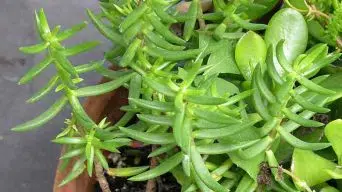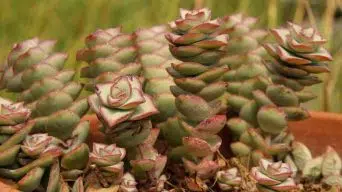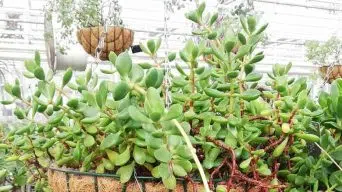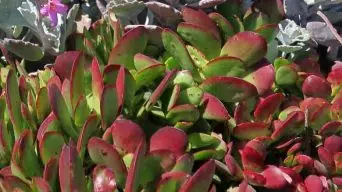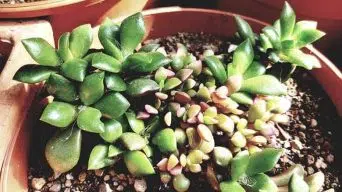The Crassula arborescens (Silver Dollar Plant) succulent is an excellent plant for beginners and more experienced gardeners.
It is easy to care for, propagates easily, and looks beautiful in any climate!
This article will cover everything you need to know about caring for your Crassula arborescens and how to propagate them.
Crassula Arborescens Overview
| Family: | Crassulaceae |
| Genus: | Crassula |
| Botanical Name: | Crassula arborescens |
| Common Names: | Silver Jade Plant, Silver Dollar Plant, Beestebul, Chinese Jade, Money Plant, Money Tree |
| Origin: | Western Cape, South Africa |
| USDA Hardiness Zones: | 9 – 11 |
| Size: | 2 to 4 feet (0.6 to 1.2 m) |
| Sun Exposure: | Full sun to partial shade |
| Water Needs: | Water thoroughly but infrequently |
| Soil Type: | Well-draining soil |
| Temperature: | 65 to 75°F (18-24°C) |
| Humidity Levels: | 40-50% |
The Crassula Arborescens, commonly known as the Silver Dollar Plant, is a succulent species in the family Crassulaceae that can grow up to 4 feet (1.2 m) tall.
The blue-gray leaves are fat and rounded and can be up to 3 inches (7.5 cm) long with maroon edges.
The Crassula Arborescens flowers are white or pink and appear around spring to summer.
Some of the names by which this plant is commonly known are:
- Silver Jade Plant
- Silver Dollar Plant
- Beestebul
- Chinese Jade
- Money Plant
- Money Tree
How To Care for Crassula Arborescens (Silver Dollar Plant)
Crassula arborescens care is not complex, but it does require some attention.
Growing the Silver Dollar Plant succulent can be very rewarding, especially if you’re starting your own garden from scratch or adding new life to one that no longer thrives from neglect.
Here are some guidelines on taking care of Crassula arborescens that will help you enjoy this plant for many years.
Sun Exposure & Light Requirements
The Crassula arborescens succulent plant prefers indirect bright light with plenty of airflow.
It is essential for the Crassula plant not to get too much direct sunlight so that its leaves don’t burn!
This type of plant prefers mostly shady locations. Still, it can withstand some morning/afternoon sunshine occasionally, as long as there’s enough water in between.
The best way to maintain this type of Crassula succulent would be a position near an east-facing window.
The Crassula arborescens succulent plant prefers to be placed indoors or outdoors where it can get natural light but not too much direct sunlight.
Watering Requirements
The Crassula arborescens succulent plant requires moderate water but can tolerate periods of drought.
It must be watered when the soil surface is dry to the touch and not allowed to get too wet or soggy.
If you notice yellow leaves, this may indicate that there has been overwatering.
The best way to maintain the correct water level is to plant it in a container with drainage holes and allow them to dry out between soakings.
Soil Requirements
Since Crassula arborescens is a succulent, it needs soil with excellent drainage.
The best type of soil to use is a cactus potting mix because it helps retain moisture. You can also add perlite if you want more aeration in your mixture.
If you prefer regular potting soil, avoiding mixing with too much peat moss is best because this can make your plant susceptible to root rot. You may want to add perlite if the mixture is heavy and doesn’t drain well.
If you plan to use a mix of soil and peat moss, it is best to stay within 25% peat moss because this can make the mixture too heavy.
Temperature and Humidity
The Crassula arborescens succulent plant does best in temperatures of around 65-75° Fahrenheit.
However, it can withstand short periods up to 88 or even 104 degrees (above that, the leaves will wilt). If you are experiencing high temperatures or drought conditions, misting is recommended every day if possible.
The Crassula arborescens succulent plant can withstand a range of humidities but does best in humidity levels between 40% and 50%. Keep this in mind when deciding where to place your Silver Dollar Plant.
Fertilizing
The Crassula arborescens (Silver Dollar Plant) is a succulent plant that does not need to be fertilized.
You should only fertilize the soil if you use organic compost, which naturally provides nutrients for your plants.
If you are growing this plant in pots or containers with a potting mix such as dirt and sand, using a balanced slow-release fertilizer is essential.
Avoid fertilizing this plant during cold weather, or the Crassula arborescens may not grow well.
However, if you fertilize your Crassula plants in these situations and start turning yellow from a nitrogen deficiency, stop applying fertilizer.
If you are growing this plant in a garden or outdoor landscape, it will not need to be fertilized.
Potting and Repotting
The Silver Dollar Plant is typically grown in a container. The soil mixture you use should be draining but not too fast-draining, or it will dry out the roots of your succulents.
When repotting Crassula arborescens, choose a pot at least one inch larger than the current pot.
Fill the new pot with pre-moistened cactus mix and place the plant inside so it’s snug to fill all gaps around its roots without being crammed down into the dirt.
After planting your Silver Dollar Plant, water it generously to settle any air pockets around the roots.
Your Crassula arborescens will need repotting every few years.
When potting your Silver Dollar Plant, you should never put it in a plastic or clay-based container. The best option is a terracotta pot.
If you are still determining what type of container to choose for repotting, then the best option is usually ceramic pots because they drain well and last longer than plastic ones.
Pruning
Following a general rule, the best time to prune is in summer, when plants are actively growing.
You can do it at any other season, but it’s not recommended since it requires more experience and might harm the plant.
Here’s how:
- Cut off rosettes that have finished their life cycle or have been damaged by pests or disease. The cut should go just above a set of leaves with no flowers.
- Remove dead leaves from around the base of the plant and trim out any browning parts.
- Only remove some foliage, as some shade will help protect against sunburn if too much light is exposed.
- Lightly prune the tips of branches to keep them short and bushy.
- Large plants can be cut back by one-third, but only if you are sure they have enough space for growth in their pots.
- Some rosettes may need to be removed from clumps with overcrowded roots or where the plant is sprawling over neighboring ones. Make a clean sweep below each leaf node (the place on a stem where leaves attach) before cutting out any parts.
You should not trim plants more than twice a year.
The rule applies even when it’s necessary to reduce flowering buds since flowers that will never open up anyway won’t do anything good for the health of your Crassula.
Pests and Diseases
Pests and diseases are rare on Crassula arborescens plants.
The most common pests that affect this plant species are mealybugs, scale insects, spider mites, or aphids.
Keep an eye out for any unusual damage to the leaves of your silver dollar succulent so you can take action if necessary.
Try a soapy water spray or neem oil if you cannot identify the pest.
The most common disease that affects Crassula arborescens plants is rot, which can be caused by too much water and poor drainage.
To avoid this problem in your succulent garden, allow excess moisture to drain away from the plant before trying again.
It’s also important not to overwater potted plants. Use a potting soil mix with perlite for best results.
How to Care for Crassula Arborescens in Winter
Crassula arborescens care during the winter is relatively straightforward but does require some attention.
- In winter, water your Crassula arborescens sparingly and no more than once every two weeks. They can survive up to a month without water in cold weather. Keep the soil lightly moist at all times during this season.
- Protect it from frost by placing an insulating material like wooden boards or straw around the plant’s base. Remove insulation when daylight hours lengthen and temperatures rise above freezing point again in late spring.
- Keep them out of drafts that might dry out their foliage – these plants love warm places!
- Remember that Crassula arborescens will not survive freezing temperatures. If you live in a cold climate, bringing your plants indoors before the first frost is best, or keeping them near an open window at night.
- If you leave your plant outdoors and find that its leaves have turned brown due to frost, don’t despair! With luck and proper care, it may be possible for the plant to recover from this setback when spring arrives again.
- Watch the plant closely for any signs of wilting or leaf discoloration. Repair drooping leaves with a light misting to stimulate growth.
If your Crassula arborescens succulent has yet to recover by the following summer, it is probably time to dispose of it and get another one.
How To Propagate Crassula Arborescens (Silver Dollar Plant)
Crassula arborescens propagation is quite easy! You can propagate the plant using leaf cutting, stem cutting, and seeds.
Leaf Cuttings
The best time to take a leaf cutting is in spring or summer when the leaves are healthier and plump.
Cut off one of the larger leaves near its base if possible – it will have more nutrients at that point than towards its tips, and easier for them to form roots.
Let callus form for a few days on the cut surfaces and plant in well-drained soil. Use a pot with drainage holes and add organic material or sand to the soil to drain well.
After planting, place in bright indirect light but not direct sun for about two weeks before gradually moving into full sunlight. The plant should form new roots within one month!
Stem Cuttings
Stem cuttings are a great way to propagate crassula arborescens.
You can take them any time of the year, but they will grow more roots in spring or summer.
Cut off a healthy stem and let it callus for a few days before planting it into well-drained soil with organic material added to it so that water drains well.
After two weeks, place them in bright indirect light, gradually moving them out over time until full sun is reached slowly (usually after about one month). The new plant can form roots in as little as one month!
Seeds
Seeds can be started sometime in the winter and grow well in the spring or summer. You must soak them for 24 hours before planting them into potting soil with organic material added so that water drains out of it quickly!
The seed should germinate within two weeks if all conditions are right! Keep moist at all times and wait patiently until you have a new plant.
Plant your succulents outside after the danger of frost has passed – they do not like their roots being too cold.
Is the Crassula Arborescens (Silver Dollar Plant) Toxic?
The Crassula arborescens is toxic to cats, dogs, and other pets.
The sap from Crassula has been shown to affect humans too, though less severe than pets – symptoms include nausea and vomiting. Still, these are unlikely unless ingested directly (e.g., via licking).
This toxicity generally manifests after ingesting large amounts of leaf material over time. However, some people experience reactions even when eating small doses of Crassula leaves.
It would be best to keep the plant out of reach from pets and children, or if you want it in your home, make sure that you grow it away from where they frequent.
Final Thoughts
The Crassula arborescens is an attractive succulent plant to look at and take care of.
It is a small but resilient plant that can survive under harsh conditions but needs some care and attention to thrive.
If you take care of it properly, this indoor plant will grow into an elegant houseplant with long stems bearing clusters of tiny white flowers.
These plants are easy to maintain if given the right environment.


